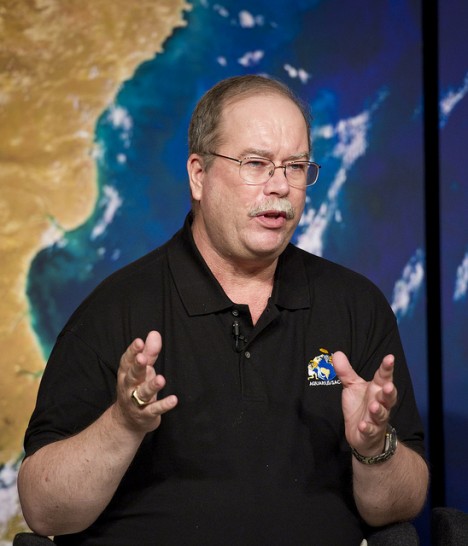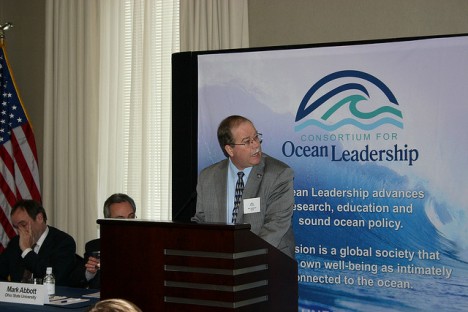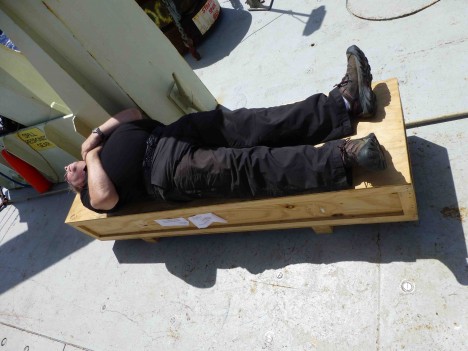By Eric Lindstrom
After several weeks of your following my postings from the field, I thought it would be good to tell you a little about myself. Maybe that will help explain the weird wanderings of the blog or the subject matters I choose to write about.
Let’s start at the beginning: I grew up in Seal Beach, California, very near the ocean. It seems to me like I actually grew up on the sand and in the water. So, I am pretty well infused and enthused by the seas. This has driven me toward a broad knowledge of ocean subjects. I felt that drive vindicated when National Geographic Society tapped me as senior scientific consultant (pro bono) on their first ocean atlas project.
When did I decide to become an oceanographer? I was pretty interested in the field in middle and high school. Science seemed like where I was headed. Being a good student, I was able to get into the Massachusetts Institute of Technology. There, before I finished my freshman year, I fell in love with the Earth and Planetary Sciences Department. It was a short course in astronomy that got me hooked. They really reeled me in when I realized that Earth science was just then being revolutionized by the ideas of plate tectonics and that oceanographers at MIT were bringing back the first pictures of hydrothermal vents on the mid-ocean ridges. There was not much in the way of undergraduate education in oceanography at MIT, but lots of good basic math, physics, geology, geophysics, and research opportunities. I can date myself by recalling the glorious summer of 1976, when I stayed in Boston for the bicentennial and to do my undergraduate research project on data from Lake Ontario. The lake wasn’t salty, but it was a great little laboratory for oceanography ideas! That summer truly set me on course to pursue physical oceanography as a career (and provided my first publication with Prof. John Bennett: “A simple model of Lake Ontario’s coastal boundary layer,” in Journal of Physical Oceanography, July 1977). Most scientists remember their first publication quite fondly and I am no exception!
Graduate school at University of Washington was filled with studies and expeditions. It took me six years to get my Masters and a Doctor of Philosophy in Physical Oceanography degrees. My dissertation was on eddies in the North Atlantic Ocean. It turned out that eddies deep below the surface of the ocean can carry water across the ocean from quite distant places and arrive in the Sargasso Sea with evidence of their origins from as far afield as the Labrador Sea, the Antarctic Circumpolar Current, or the Mediterranean Sea. The idea that these origins and travels could be traced using salinity measurements was intoxicating (in a nerdy sort of a way) for a young oceanographer. I loved the data collection part of the project; being part of the right team with the right equipment in the right place at the right time to make some discovery that would move science forward. The ocean is still virtually unexplored, so every well-planned expedition has potential for great discovery. Once oceanographic expedition science is in your blood, it’s hard to give it up! I found a great opportunity for doing more expedition research by moving to Australia in 1983. The country had expanded ocean research greatly at that time due to advent of the Law of the Sea and extended Exclusive Economic Zones. Sometimes, timing is everything!
In Australia, I became engrossed in studies of the western tropical Pacific Ocean circulation and in the planning for the World Ocean Circulation Experiment (WOCE). By the end of the 1980s, the former had seen me on many expeditions near exotic tropical islands and the latter looked to be the oceanography opportunity of the 1990s. I moved back to the U.S., still working on the same projects, but with a new home base. By the mid-1990s I was the US WOCE Program Scientist in Washington, D.C. That involved organizing scientific plans, budgets, and logistics for the largest mapping of ocean waters ever undertaken, involving voyages across the globe for nearly a decade. I was bitten by the vision of global ocean observing provided by WOCE and still suffer from that fever.
When the opportunity arose in 1997 to lead NASA’s Physical Oceanography Program, I had the right stuff: solid experience with the ocean, ocean programs in DC, ocean researchers in general, and virtually no heritage at all with satellite oceanography (but NASA said I could learn that on the job!)
It was in my first days at NASA HQ that I began energizing NASA’s drive toward measuring ocean salinity from space. All I had to do was enable those with the knowledge and skill to realize the dream (it certainly was not a new idea) – and prove to NASA that it was both possible and useful. And here we are today. I am back out on a research vessel, doing what I love, with Aquarius, our ocean surface salinity instrument, on orbit overhead and a whole community of scientists curious about ocean salinity and the global water cycle. It’s one small victory for this man, and one giant leap for physical oceanography.
Tags: oceanography, oceans, science careers, SPURS, SPURS1







Frage: Beinhaltet das auch die Erforschung, woher diese Monsterwellen kommen?
Vielen Dank für den Kommentar! Wir sucher eher nach extremen Oberflächensalzgehalten als nach extremen Wellen, aber der tropische Sturm Nadine hat uns einige Wellen über 4 Meter beschert! Alles Gute von der Mitte des Atlantiks.
Thanks Eric for sharing your career story. I owe Eric some credit for stimulating my interest in oceanography and my current job of leading the management team responsible for many of the global ocean measurements like Argo.
I am enjoying your blog. We at NOAA are very pleased to contribute to SPURS. We look forward to hearing even more about SPURS and what it can tell us about the beautiful and interesting Sargasso Sea.
Thanks for taking time out of your busy schedule to read our SPURS blog! We appreciate all the support provided by your office (NOAA Climate Observations) to SPURS. We really could not do SPURS (well) without the context provided by the basin-scale Argo and drifter arrays (to which SPURS is adding materially) and the historical data from the XBT lines, Thermosalinographs, and PIRATA moored array. All these great things you support! One of the things we hope to help you with is the proof that the PICO moorings (two in SPURS from NOAA PMEL) are ready for prime time, so to speak. They look to be doing great right now.
Born and raised next to the sea – my love of the sea and its secrets is well-ingrained. Thank you for the biographical overview. I can well understand your connection to the sea – it is something not everyone can appreciate.
Michelle,
It great to hear that the blog has resonated with you. Don’t be bashful about sharing your suggestions for future blogs addressing questions of oceanography.